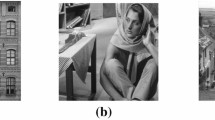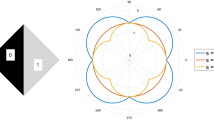Abstract
We study an adaptive anisotropic Huber functional-based image restoration scheme. Using a combination of L2–L1 regularization functions, an adaptive Huber functional-based energy minimization model provides denoising with edge preservation in noisy digital images. We study a convergent finite difference scheme based on continuous piecewise linear functions and use a variable splitting scheme, namely the Split Bregman (In: Goldstein and Osher, SIAM J Imaging Sci 2(2):323–343, 2009) algorithm, to obtain the discrete minimizer. Experimental results are given in image denoising and comparison with additive operator splitting, dual fixed point, and projected gradient schemes illustrates that the best convergence rates are obtained for our algorithm.












Similar content being viewed by others
Notes
Semen Aronovich Geršgorin’s work [23] in 1930 was the first paper to treat the important topic of the convergence of finite-difference approximations to the solution of Laplace-type equations.
We assume Gaussian noise, i.e., \(n\sim \mathcal {N}(0,\sigma _n)\).
Note we use the notation \(\nabla \) to denote the gradient and in the space of bounded variation functions BV it is infact a Radon measure and is understood in the sense of distributions. The equality \(\int _{\Omega } \left| Du \right| = \int _{\Omega } \left| \nabla u \right| \) dx is true when \(u\in W^{1,1}(\Omega )\).
Evolution of the Step edge synthetic image mesh under different schemes is available as movies in the supplementary material.
Using MATLAB command imnoise(\(u_0\),’gaussian’,0,\(\sigma _n\))
Using MATLAB command edge(\(u_0\),‘canny’). The edges are computed from each of the red, green, and blue channels (images) and the final result is shown by combining them again into a color image. Note that the Canny edge detector employs non-maximal suppression to avoid small scale edges.
References
Aubert G, Kornprobst P (2006) Mathematical problems in image processing: partial differential equation and calculus of variations. Springer-Verlag, New York
Beck A, Teboulle M (2009) Fast gradient-based algorithms for constrained total variation image denoising and deblurring problems. IEEE Trans Image Process 18(18):2419–2434
Black MJ, Rangarajan A (1996) On the unification of line processes, outlier rejection, and robust statistics with applications in early vision. Int J Comput Vis 19(1):57–91
Black MJ, Sapiro G, Marimont DH, Heeger D (1998) Robust anisotropic diffusion. IEEE Trans Image Process 7(3):421–432
Carlini E, Ferretti R (2012) A semi-Lagrangian approximation for the AMSS model of image processing. Appl Numer Math 73:16–32
Caselles V, Sapiro G, Chung DH (2000) Vector median filters, inf-sup operations, and coupled PDE’s: theoretical connections. J Math Imaging Vis 12(2):109–119
Chambolle A (1995) Image segmentation by variational methods: Mumford and Shah functional and the discrete approximations. SIAM J Appl Math 55(3):827–863
Chambolle A (1999) Finite-differences discretizations of the Mumford–Shah functional. M2AN Math Model Numer Anal 33(2):261–288
Chambolle A (2004) An algorithm for total variation minimization and applications. J Math Imaging Vis 20(1–2):89–97
Chambolle A, Levine S, Lucier BJ (2011) An upwind finite-difference method for total variation based image smoothing. SIAM J Imaging Sci 4(1):277–299
Chambolle A, Lions PL (1997) Image recovery via total variation minimization and related problems. Numer Math 76(2):167–188
Chambolle A, Pock T (2011) A first-order primal-dual algorithm for convex problems with applications to imaging. J Math Imaging Vis 40(1):120–145
Chan TF, Mulet P (1999) On the convergence of the lagged diffusivity fixed point method in total variation image restoration. SIAM J Numer Anal 36(2):354–367
Chan TF, Shen J (2005) Image processing and analysis: variational, PDE, wavelet, and stochastic methods. Society for Industrial and Applied Mathematics, Philadelphia
Chen K (2005) Adaptive smoothing via contextual and local discontinuities. IEEE Trans Pattern Anal Mach Intell 27(10):1552–1567
Chen Y, Levine S, Rao M (2006) Variable exponent, linear growth functionals in image restoration. SIAM J Appl Math 66(4):1383–1406
Chu CK, Glad IK, Godtliebsen F, Marron JS (1998) Edge-preserving smoothers for image processing. J Am Stat Assoc 93(442):526–541
de Araujo AF, Constantinou CE, Tavares JMRS (2014) New artificial life model for image enhancement. Expert Syst Appl 41(13):5892–5906
de Araujo AF, Constantinou CE, Tavares JMRS (2016) Smoothing of ultrasound images using a new selective average filter. Expert Syst Appl 60:96–106
Dobson DC, Vogel CR (1997) Convergence of an iterative method for total variation denoising. SIAM J Numer Anal 34(5):1779–1791
Geman S, Geman D (1984) Stochastic relaxation, Gibbs distribution and the Bayesian restoration of images. IEEE Trans Pattern Anal Mach Intell 6(6):721–741
Geman S, McClure D (1987) Statistical methods for tomographic image reconstruction. In: Proceedings of the 46th session of the ISI, bulletin of the ISI, vol 52, pp 22–26
Gersgorin SA (1930) Fehlerabschätzung für das differenzverfahren zur lösung partieller differentialgleichungen. J Angew Math Mech 10:373–382
Giusti F (1984) Minimal surfaces and functions of bounded variation. Birkhauser, Basel
Glowinski R, Marrocco A (1975) Sur lapproximation par elements finis dordre un, et la resolution par penalisation-dualite dune classe de problemes de dirichlet nonlineaires. Rev Francaise dAut Inf Rech Oper R(2):41–76
Goldstein T, Bresson X, Osher S (2010) Geometric applications of the split Bregman method: segmentation and surface reconstruction. J Sci Comput 45(1–3):272–293
Goldstein T, Osher S (2009) The split Bregman algorithm for L1 regularized problems. SIAM J Imaging Sci 2(2):323–343
Gulo CASJ, de Arruda HF, de Araujo AF, Sementille AC, Tavares JMRS (2016) Efficient parallelization on gpu of an image smoothing method based on a variational model. J Real-Time Image Proc 1–13. doi:10.1007/s11554-016-0623-x
Huber PJ (1981) Robust statistics. Wiley, New York
Jia R-Q, Zhao HQ, Zhao W (2009) Convergence analysis of the Bregman method for the variational model of image denoising. Appl Comput Harmon Anal 27(3):367–379
Jiang Q (2012) Correspondence between frame shrinkage and high-order nonlinear diffusion. Appl Numer Math 62(1):51–66
Kaccur J, Mikula K (1995) Solution of nonlinear diffusion appearing in image smoothing and edge detection. Appl Numer Math 17(1):47–59
Li SZ (1995) Markov field random modeling in computer vision. Springer, Berlin
Perona P, Malik J (1990) Scale-space and edge detection using anisotropic diffusion. IEEE Trans Pattern Anal Mach Intell 12(7):629–639
Prasath VBS (2011) Weighted Laplacian differences based multispectral anisotropic diffusion. In: IEEE international geoscience and remote sensing symposium (IGARSS), pp 4042–4045, Vancouver BC, Canada
Prasath VBS (2011) A well-posed multiscale regularization scheme for digital image denoising. Int J Appl Math Comput Sci 21(4):769–777
Prasath VBS, Moreno JC, Palaniappan K (2013) Color image denoising by chromatic edges based vector valued diffusion. Preprint, 2013. Available at http://arxiv.org/abs/1304.5587
Prasath VBS, Singh A (2010) A hybrid convex variational model for image restoration. Appl Math Comput 215(10):3655–3664
Prasath VBS, Singh A (2010) Multispectral image denoising by well-posed anisotropic diffusion scheme with channel coupling. Int J Remote Sens 31(8):2091–2099
Prasath VBS, Singh A (2010) Well-posed inhomogeneous nonlinear diffusion scheme for digital image denoising. J Appl Math 14 :763847. doi:10.1155/2010/763847
Prasath VBS, Singh A (2012) An adaptive anisotropic diffusion scheme for image restoration and selective smoothing. Int J Image Graph 12(1):18
Prasath VBS, Vorotnikov D (2012) On a system of adaptive coupled PDES for image restoration. J Math Imaging Vis, Online First, 2012. Available at arXiv:1112.2904
Rey WJJ (1983) Introduction to robust and quasirobust statistical methods. Springer-Verlag, Berlin
Rivera M, Marroquin JL (2003) Efficient half-quadratic regularization with granularity control. Image Vis Comput 21(4):345–357
Rudin L, Osher S, Fatemi E (1992) Nonlinear total variation based noise removal algorithms. Phys D 60(1–4):259–268
Scherzer O, Grasmair M, Grossauer H, Haltmeier M, Lenzen F (2009) Variational methods in imaging. Springer-Verlag, New York
Setzer S (2011) Operator splittings, Bregman methods and frame shrinkage in image processing. Int J Comput Vis 92(3):265–280
Shi Y, Chang Q (2008) Acceleration methods for image restoration problem with different boundary conditions. Appl Numer Math 58(5):602–614
Spitaleri RM, March R, Arena D (2001) A multigrid finite-difference method for the solution of Euler equations of the variational image segmentation. Appl Numer Math 39(2):181–189
Szeliski R, Zabih R, Scharstein D, Veksler O, Kolmogorov V, Agarwala A, Tapen M, Rother C (2008) A comparative study of energy minimization methods for Markov random fields with smoothness based priors. IEEE Trans Pattern Anal Mach Intell 30(6):1068–1080
Tikhonov AN, Aresenin VY (1997) Solutions of ill-posed problems. Wiley, New York
Tukey JW (1977) Exploratory data analysis. Addison-Wesley Publishers, Reading, MA, USA
Weickert J (1998) Anisotropic diffusion in image processing. B.G. Teubner-Verlag, Stuttgart
Weickert J, Romeny BMH, Viergever MA (1998) Efficient and reliable schemes for nonlinear diffusion filtering. IEEE Trans Image Process 7(3):398–410
Weiss P, Blanc-Feraud L, Aubert G (2009) Efficient schemes for total variation minimization under constraints in image processing. SIAM J Sci Comput 31(3):2047–2080
Wu T-T, Yang Y-F, Pang Z-F (2012) A modified fixed-point iterative algorithm for image restoration using fourth-order PDE model. Appl Numer Math 62(2):79–90
Xu G (2013) Consistent approximations of several geometric differential operators and their convergence. Appl Numer Math 69:1–12
Zhu M, Chan TF (2008) An efficient primal-dual hybrid gradient algorithm for total variation image restoration. Technical report 08–34, UCLA CAM
Zhu M, Wright SJ, Chan TF (2010) Duality-based algorithms for total-variation-regularized image restoration. Comput Optim Appl 47(3):377–400
Author information
Authors and Affiliations
Corresponding author
Additional information
Communicated by José Mario Martínez.
Rights and permissions
About this article
Cite this article
Prasath, V.B.S., Moreno, J.C. On convergent finite difference schemes for variational–PDE-based image processing. Comp. Appl. Math. 37, 1562–1580 (2018). https://doi.org/10.1007/s40314-016-0414-9
Received:
Revised:
Accepted:
Published:
Issue Date:
DOI: https://doi.org/10.1007/s40314-016-0414-9




